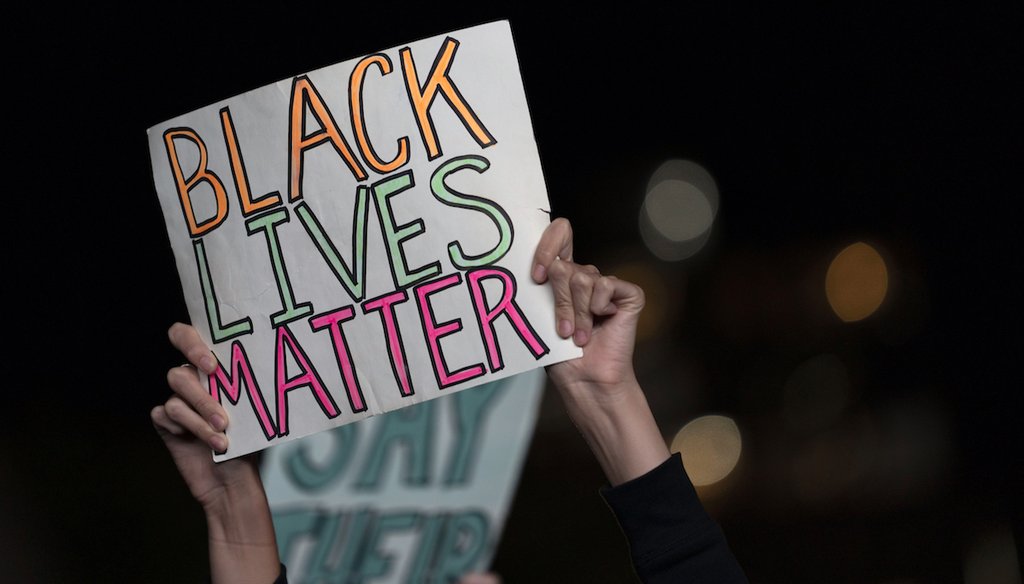Stand up for the facts!
Our only agenda is to publish the truth so you can be an informed participant in democracy.
We need your help.
I would like to contribute

A protester holds up a Black Lives Matter sign as she and others gather in the Brooklyn borough of New York, late Wednesday, Sept. 23, 2020, in New York, following a Kentucky grand jury's decision on the killing of Breonna Taylor. (AP)
Since Kentucky’s attorney general announced on Sept. 23 that the officers who shot and killed Breonna Taylor would not face criminal charges in her death, the grief over what some people consider a miscarriage of justice has manifested in more protests in Louisville and around the country.
The reaction spilled over online in the form of social media posts comparing Taylor’s death in March to that of another woman who was shot and killed by a police officer: Justine Damond.
"This is why 12 million is a SLAP IN THE FACE," begins one Facebook post, referring to how much money the city of Louisville agreed to pay Taylor’s family in a wrongful-death lawsuit concerning her killing.
"Meet Justine Diamond," the post says, misspelling Damond’s name. "She is an AUSTRALIAN-AMERICAN who was gunned down by a Minneapolis police officer (who is black) as she approached a squad car. Her killer Mohammed Noor was promptly arrested, tried and convicted. Not only that. The family of Justine Diamond was awarded $55,000,000 in a settlement."
The post shows two photos. One of Damond, who is white, and one of Taylor, who is Black.
"Two women, killed wrongly by those sworn to protect," the post continues. "But a $40,000,000 gap in how their lives are VALUED. But "ALL LIVES MATTER" right? Just not the same apparently. But it gets better… Not only that, but one’s killer is in jail ...the other’s killer is clocking in for work as we speak."
This post was flagged as part of Facebook’s efforts to combat false news and misinformation on its News Feed. (Read more about our partnership with Facebook.)
We wanted to lay out the details in the two cases, which are not identical. The post is also not entirely accurate.
Here’s what we know about Damond’s death.
On July 15, 2017, Justine Ruszczyk Damond called Minneapolis police to report a possible assault in the alley behind her home, according to the Star Tribune. Minneapolis police officers Mohamed Noor and Matthew Harrity responded to the call but found nothing suspicious at the scene. They were getting ready to leave when they saw Damond outside the police car. Harrity, who was in the driver’s seat, said he was "spooked, and drew his gun. Noor reached across from the passenger's seat and shot Damond out the driver’s side window.
On March 20, 2018, eight months after Damond’s death, Noor, who is Black, was booked in jail on charges of third-degree murder and second-degree manslaughter. The county attorney said he had behaved "recklessly" and that an investigation uncovered no evidence Noor "encountered, appreciated, investigated or confirmed a threat that justified the decision to use deadly force."
On May 1, 2019, Noor was found guilty of third-degree murder and manslaughter.
A few days later, the city of Minneapolis agreed to pay a record $20 million to Damond’s family to settle the wrongful death lawsuit in her killing. That’s less than the Facebook post says, and less than what her family sought: $50 million for violating Damond’s constitutional rights. But the compensation was also close to double what Taylor’s family accepted from the city of Louisville — $12 million.
In June, Noor was sentenced to 12 1/2 years in prison.
As the Star Tribune reported, the case drew international attention and "raised questions about the role of race and gender in the prosecution of officer-involved shootings." Noor is Black and born in Somalia, and Damond was white and born in Australia.
By comparison, the three officers who fired their weapons after barreling into Breonna Taylor’s home with a search warrant on March 13 are white. The two officers who shot Taylor six times were not charged and they were not fired, according to the New York Times. Prosecutors said they were justified in their use of force because they had identified themselves as police and Taylor’s boyfriend, Kenneth Walker, shot at them first. Walker has said he and Taylor didn’t know who was at the door.
On Sept. 23, six months after Taylor’s death, the third officer, Brett Hankison, was charged with reckless endangerment for firing into a neighboring apartment. The attorney general said none of the rounds he fired hit Taylor.
He was terminated from the police department in June.
The warrant for Taylor’s apartment, signed by a local magistrate, was one of several in a case involving Taylor’s ex-boyfriend, who police believed was running a drug trafficking syndicate. The New York Times has published a long story detailing Taylor’s life and how she wound up in the middle of a drug raid on the night of her death.
She had no criminal record and she was never the target of the police’s investigation, the New York Times reported.
Our Sources
Facebook post, Sept. 23, 2020
The New York Times, Fired officer is indicted in Breonna Taylor case; protesters wanted stronger charges, Sept. 23, 2020
The New York Times, Breonna Taylor’s family to receive $12 million settlement from city of Louisville, Sept. 15, 2020
Minneapolis Star-Tribune, The fatal shooting of Justine Damond by Mohamed Noor, visited Sept. 24, 2020
Minneapolis Star-Tribune, Minneapolis police officer Mohamed Noor turns himself in on murder, manslaughter charges in Justine Damond killings, March 21, 2020
Minneapolis Star-Tribune, Mohamed Noor guilty of third-degree murder, manslaughter in killing of Justine Ruszczyk Damond, May 1, 2019
Minneapolis Star-Tribune, Minneapolis agrees to pay $20 million in death of Justine Ruszcyzk Damond, May 4, 2019
The New York Times, Breonna Taylor’s life was changing. Then the police came to her door, Aug. 30, 2020




















